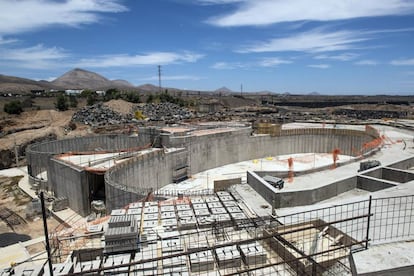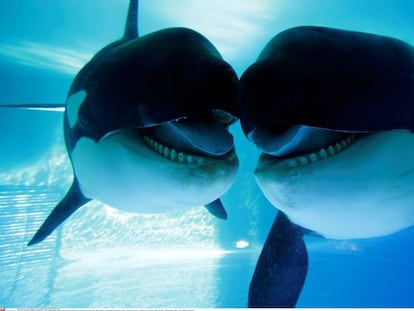With so many dolphins in captivity, Spain is swimming against the tide
More than half the dolphins held in aquariums are owned by Spanish companies


A dolphin called Buffalo Bill serves hamburgers and chips while another in a cowboy dress jumps repeatedly through a hoop. Part of an “educational” spectacle, the animals are photographed by a British family being led around the pool by Fiona, a sea lion who nudges them forward with her nose while winning over her audience with cute “human” gestures.
In the same park, children’s cries blend in with the squawking of parrots overhead, beers come and go in big plastic cups and a vulture flies just meters above the crowds, close to where two albino tigers are dozing off, clearly bored by the constant pointing of cellphones in their direction.
When Lanzarote’s marine park is up and running, Spain will have 12 dolphinaria; the rest of Europe has just 18
At Rancho Texas on the Canary Island of Lanzarote, the atmosphere is supposed to be fun and festive, a model replicated in many other Spanish theme parks and zoos designed for our entertainment. Children eager to catch a glimpse of their favorite animal keep the turnstiles busy. And they are about to get busier; the complex has just finished building three gigantic pools for a new dolphin exhibit.
When the mammals are brought to Rancho Texas, Spain will have exactly 100 dolphins in captivity – compared to the total of 183 throughout the rest of Europe. The park is hoping to hike its visitor count by 15% with the new attraction. It will also reinforce Spain’s reputation as the dolphinarium of Europe, home to 12 of the 31 dolphin attractions in the rest of the EU, where the prevailing trend is to close such places down.
Thanks to pressure from animal rights activists, conditions are better here than those in Russia, for example, where Cetaceans form part of traveling circuses and are kept in tanks small enough to distress a tropical fish. They have also moved beyond the carrot-and-stick method of training, using instead the reinforcement of desired behavior.
It is actually against the law to put on commercial dolphin shows unless they have an educational, investigative or conservational element
A month ago, 100 animal welfare activists picketed Rancho Texas in Tías, as well as organizing an online protest that went viral. The activists expressed incredulity that a new “dolphin prison” should be hosted on an island declared a biosphere reserve. “The harmony between man and nature in Lanzarote is undoubtedly why we have been internationally recognized,” says a spokesperson for Lanzarote local council, ignoring the fact that cetaceans can be seen swimming wild off the coast here, a far more thrilling and educational spectacle than could ever be produced in a park.
Rancho Texas owner Nicolás López is keen to point out that the dolphinarium is low-density. Despite room for 18 to 20 dolphins, there will only be eight when the enclosure is ready at the end of the year. He also emphasizes the five-star conditions that have cost €7 million, including purified water and cutting-edge facilities.
Seven of Spain’s marine parks are in the hands of two multinationals. One of these is Parques Reunidos, a public company that turned over €605 million in 2015. It owns the Madrid Zoo where there are 11 dolphins, Aquópolis in Tarragona, which has eight, and Selwo in Málaga, which keeps six. Other national assets include Madrid’s Parque de Atracciones and the Warner Park, while internationally, it has Marineland Antibes, France’s biggest aquatic zoo, which has 11 dolphins and four orcas. Altogether, including its theme parks in the United States and Mexico, Parques Reunidos has accumulated 96 dolphins and six killer whales.
Another Spanish multinational, Aspro Ocio owns Aqualand in Tenerife, with 11 dolphins, Marineland in Barcelona and Mallorca, which have six and seven respectively, and Palmitos Park in Las Palmas, which has five. Aspro has also bought Boudewijn Seapark in Belgium, which has nine dolphins, along with a Dutch dolphinarium called Harderwijk – the biggest in Europe with 36 dolphins and six porpoises. Spanish companies own 55% of the dolphins on the continent – or, 156 of the 283
Swimming against the tide
But Spain is out of step with the rest of Europe, which is moving toward the closure of such facilities. In Britain, these parks disappeared 25 years ago. In 2015, Finland closed its only center and Poland put the brakes on the building of what would have been its first. Fourteen EU member states have banned captive cetacean facilities, Switzerland coming on board in 2012 after two dolphins died.
Outside of Europe, Costa Rica, Chile, Uruguay, large swathes of Australia and some states in America are dolphinaria-free zones, as is India, which declared in 2013 that “dolphins should be seen as ‘non-human persons’ and as such should enjoy their own specific rights.”
“These dolphin shows are purely for entertainment,” says Miriam Martínez, spokesperson for the SOS Dolphin Campaign and an activist with the Foundation for Advice and Action in the Defense of Animals (FAADA). “They are no better than circuses and should be banned.”
Thanks to multinationals Aspro Ocio and Parques Reunidos, Spanish companies control more than half the Dolphins in Europe
Martínez is heavily critical of the conditions the cetaceans are kept in at the dolphinaria. Taken out of their natural habitat and separated from their group, she points out that captivity produces high levels of stress and early mortality rates. In response, the Iberian Association of Zoos and Aquariums (AIZA) claims there are no scientific grounds for distinguishing between a lion in captivity and a dolphin, in spite of the latter’s intelligence, self-awareness and cognitive behavior.
In 2003, legislation was introduced in Europe banning commercial cetacean performances unless they could be considered in some way educational or conducive to research or breeding. Zoo regulations in Spain also stipulate an educational, conservational or research factor. But if there’s one thing all the experts agree on, it is that these regulations are not properly enforced.
Some centers pay lip service to the educational requirement by putting up a notice with information on cetaceans in English and German as well as Spanish. Others don’t bother at all, focusing instead on pleasing the crowds with clownish tricks performed to deafeningly loud music. AIZA recognizes that there is a lack of national coherence in this respect and to what degree the regulations are enforced depends on the regional government.
“The law is very relaxed,” says Daniel García, a vet at Oceanográfico in Valencia, where 13 dolphins and two Beluga whales are kept captive. “Sometimes the inspectors don’t have the right training; they come from slaughterhouses or restaurants and they arrive at the zoo with little idea of what they are looking for. Just weighing the dolphins every day and taking blood samples does not constitute research.”
In Spain, there are zoos and aquaria with an educational purpose and spectacles that are nothing more than pure entertainment
“There needs to be pressure to raise standards,” says Javier Almunia, spokesperson for Loro Parque, a zoo in Tenerife that has not escaped the notice of animal rights activists for keeping six orcas on its premises. Meanwhile, Jesús Fernández, director of the Parque Reunidos zoo, defends his track record by pointing to a study on animal welfare that the zoo has just launched with the University of Barcelona and another on educational impact with Madrid’s Complutense University.
SOS Dolphins carried out its own study on Spanish dophinaria, concluding that just 6% of the average dolphin attraction in Spain had anything to do with education or conservation. They propose building sanctuaries for cetaceans – a kind of enclosed bay – where they would live protected but free, given that their chances of survival in the wild are diminished by long periods of captivity and the fact that 60% have actually been bred in dolphinaria. The cost of just one of these sanctuaries, according to Martínez, would come to between €17 and €43 million.
Mimics
“A dolphin is not a shark; it needs stimulation, it needs to play. It hates to be bored,” says García from Oceanográfico. “But there’s no place for tricks like the burning hoop these days. The visitors have to have a good time but they have to take something away; they have to receive a clear message in favor of conservation.”
Animal rights activists believe that watching a dolphin in a dolphiarium is far from educational, given that a dolphin’s behavior in captivity has little to do with its behavior in the wild. “A country that tries to fuel tourism with animals made to perform circus tricks is a country with very poor standards,” says Pedro Pozas, President of the Great Ape Project, who is demanding that the Canary Islands’ regional parliament declare the archipelago a free zone for dolphins. The same proposal was made in Lanzarote by Podemos – the only political party that has spoken out against the new dophinarium – but to no avail.
The European Association for aquatic mammals (EAAM) has set out guidelines, stating that cetacean shows should avoid “stupid” commentaries, clownish tricks or human gestures. But these rules apply only to members, such as the zoo in Barcelona, which has dispensed with dolphin shows, but that still keeps dolphins in tanks for tourists to observe – “the result of modernization,” according to Barcelona City Hall, which owns the park.
Animal rights activists have had more luck influencing this zoo because it is publicly owned. Besides, either the mayor, Ada Colau approves funding to increase the size of the dolphin tanks to EAAM’s specifications, or the mammals will have to be transferred elsewhere by 2019. Activists are already demanding the closure of the facility, and if they get their way, they hope it will be the first step to closing down all of Spain’s dolphin prisons.
English version by Heather Galloway.
Where are the dolphins coming from?
International law may allow it, but the EU made it illegal to import dolphins hunted in the wild in 2003. As a result, marine parks in Europe have started breeding dolphins in captivity.
Though animal rights activists insist dolphins are still being brought in from the wild, largely hunted by the Japanese, most dolphinaria have signed up for the breeding in captivity option that requires them to guarantee the rights of the animals to reproduce naturally and prohibits breeding for commerce. In Europe, this program is coordinated by Niels van Elk, the chief vet at the Dutch dolphinarium, Harderwijk, which was recently bought by the Spanish company, Aspro.
Van Elk is proposing that animals should be moved between dolphinaria to assure the genetic conservation of the species and the wellbeing of the dolphins. The problem is that dolphinaria are free to sign up to the program and if they choose not to, there is nothing to stop them from breeding dolphins to sell them.
Tu suscripción se está usando en otro dispositivo
¿Quieres añadir otro usuario a tu suscripción?
Si continúas leyendo en este dispositivo, no se podrá leer en el otro.
FlechaTu suscripción se está usando en otro dispositivo y solo puedes acceder a EL PAÍS desde un dispositivo a la vez.
Si quieres compartir tu cuenta, cambia tu suscripción a la modalidad Premium, así podrás añadir otro usuario. Cada uno accederá con su propia cuenta de email, lo que os permitirá personalizar vuestra experiencia en EL PAÍS.
¿Tienes una suscripción de empresa? Accede aquí para contratar más cuentas.
En el caso de no saber quién está usando tu cuenta, te recomendamos cambiar tu contraseña aquí.
Si decides continuar compartiendo tu cuenta, este mensaje se mostrará en tu dispositivo y en el de la otra persona que está usando tu cuenta de forma indefinida, afectando a tu experiencia de lectura. Puedes consultar aquí los términos y condiciones de la suscripción digital.
More information










































